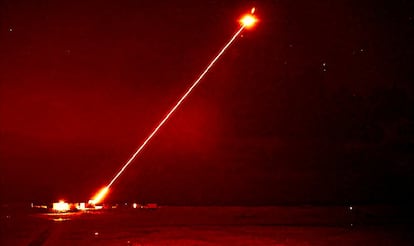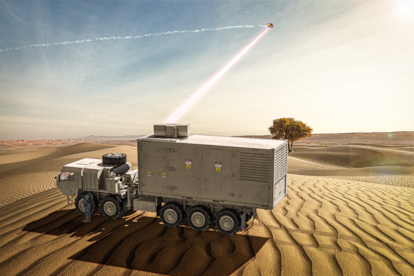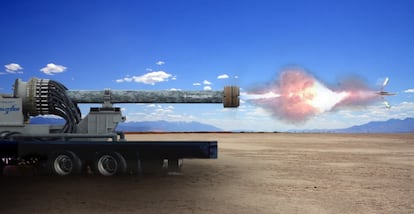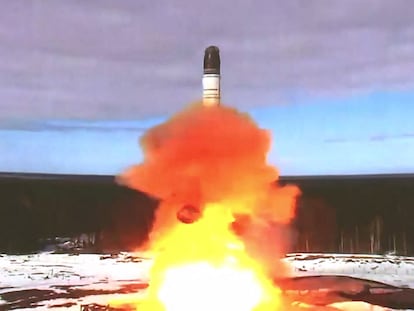Futuristic weapons: laser guns and shockwaves hint at killer robots
Technological evolution exploits the lack of regulation to develop highly destructive tools that are almost fully autonomous

The British Ministry of Defense has successfully tested the DragonFire, a powerful military laser that can pinpoint a coin a kilometer away, costing less than $13 (€12) per shot. Military technological advancements have accelerated recently, bringing us closer to autonomous weapons and killer robots. Soldiers now have the ability to engage in deadly combat from thousands of miles away. The arms industry continues to evolve, and has developed hypersonic missiles, uncrewed vessels and kinetic cannons. Meanwhile, regulation of such weapons remains elusive.
“Nations engage in diplomacy while simultaneously pursuing an arms race. The delays in decision-making can be confusing. There is a lack of transparency and genuine exchange of information regarding their [weapons] research and development efforts. They seem to be focused on diverting attention and keeping us distracted,” said Reyes Jiménez, a professor at Pablo de Olavide University (Seville, Spain) and member of the United Nations group on Lethal Autonomous Weapons Systems (LAWS). The arms race has accelerated recently — here are some of the latest developments.
Laser-directed energy weapons
The DragonFire, which cost $126 million (€117 million) to develop, is a laser-directed energy weapon that, according to the British government, “can engage targets at the speed of light, and use an intense beam of light to cut through the target, leading to structural failure or more impactful results if the warhead is targeted. Firing it for 10 seconds is the cost equivalent of using a regular heater for just an hour. Therefore, it has the potential to be a long-term low-cost alternative to certain tasks missiles currently carry out. The cost of operating the laser is typically less than £10 [$12.65] per shot.” This low cost makes it a viable substitute for ballistic missiles.

“This advanced weaponry has the potential to transform the battlefield by reducing dependence on costly munitions and minimizing collateral damage,” said UK Defense Secretary Grant Shapp. The U.S. military is also developing this technology for attack missions and countering cruise missiles. The U.S. Navy has tested laser-directed energy systems and prototypes, which are currently installed on select ships for experimental purposes.
Hypersonic missiles
Hypersonic Attack Cruise Missiles (HACM) are capable of flying and maneuvering at speeds exceeding Mach 5 (five times the speed of sound), making them much more difficult to detect and intercept compared to traditional ballistic missiles.

The U.S. Air Force has awarded a $1.4 billion (€1.29 billion) contract to Raytheon Missiles and Defense to develop and demonstrate HACM prototypes. “The [contract] will allow the company to conduct supplementary research, development, test and evaluation work for the HACM program through 2028,” an Air Force spokesperson recently told DefenseScoop.
Russian Defense Ministry spokesperson Igor Konashenkov has confirmed the use of Kinzhal hypersonic missiles to target “important elements of Ukrainian military infrastructure.” China also claims to have this type of weaponry, and has conducted a simulated naval assault using satellites to disrupt radar activity and prevent detection of the missile.
Electromagnetic attacks
The latest Chinese weapons test reveals a new strategy targeting electromagnetic systems. According to a recent U.S. Air Force publication, electromagnetic spectrum operations “seek access to communication, navigation and location systems to detect, exploit, degrade, disrupt and circumvent operational capabilities.”

Kinetic energy
China is currently exploring the use of non-explosive projectiles that utilize electromagnetic technology. These projectiles can achieve hypersonic speeds and convert kinetic energy into destructive shock and heat waves. According to the South China Morning Post, the China Aerodynamic Research and Development Center has conducted simulations using a high-speed kinetic energy weapon weighing just 20 kilos (44 pounds) that could stop a 60-ton U.S. tank in its tracks. The impact creates a shockwave that goes through the tank, putting severe stress on its structure and causing distortion and fractures. The United States has also shown interest in the railgun weapon system being developed by the General Atomics Electromagnetic Systems Group (GA-EMS) that features electromagnetic launchers that use electricity instead of chemical propellants to fire projectiles at high speeds.
Low Altitude Stalking and Strike Ordnance
LASSO weapons are deadly unmanned systems intended to be carried by troops on the battlefield. They have a short barrel for launching, a drone with a lethal payload, sensors and precise flight controls. These weapons can fly, track and attack targets and armored vehicles even when they are not in the line of sight.

Subsonic drones
Swarms of drones are widely used on battlefields. Anduril has developed a drone that intercepts and destroys enemy aircraft, then returns to base for reuse. “Roadrunner is a reusable, vertical take-off and landing (VTOL), operator-supervised Autonomous Air Vehicle (AAV) with twin turbojet engines and modular payload configurations that can support a variety of missions.”

The Air Launched Effects (ALE) program uses a different strategy of deploying small drones and payloads that can be launched from the air by larger aircraft (autonomous or crewed).
Uncrewed vessels
Similar to well-known aerial drones, Uncrewed Surface Vessels (USV) are autonomous boats used for anti-submarine and mine warfare missions. The United States has four USVs and recently conducted five months of tests in the Pacific.

“Our goal is to expose these vessels to diverse scenarios and conditions to understand their limitations. By doing so, we minimize the risks in our uncrewed operations,” said Navy Captain Scot Searles, program manager of Unmanned Maritime Systems.
Last December, Boeing delivered its first Orca to the U.S. Navy. The Orca is an 85-ton, 26-meter, high-strength autonomous underwater drone with a modular payload bay. It can navigate long distances and lay mines or perform other missions without a crew on board.
Artificial intelligence
These examples showcase recent advancements in weapon technology, propelled by the integration of artificial intelligence tools. These tools have permeated all facets of warfare, encompassing system design, including cyber attacks, as well as the manufacturing and operation of devices.
During a meeting at IBM Research in Zurich, Navantia’s (the second-largest Spanish defense company after Airbus) Joaquín de los Santos presented a paper about the growing military use of artificial intelligence. “Initially, AI was utilized in human resources, finance and legal departments. Then, it found its way into industrial processes through the creation of digital twins [a digital representation of a physical object, person or process]. Now, AI is being integrated into defense scenarios that demand rapid decision-making in challenging conditions with little data.”
Technological advancements and convergence have led to the development of systems that are close to becoming lethal autonomous weapons. Commonly known as killer robots, they are causing growing concern throughout the international community. During the Convention on Certain Conventional Weapons in November 2023, over 100 nations advocated unsuccessfully for legally binding rules on autonomous weapons systems.
After 10 years of observing and participating in efforts to manage the risks associated with robotics and emerging technologies, Jiménez has become pessimistic. Proposed solutions often contradict the consensus decision-making rule, which major players in the arms industry repeatedly disregard. “We can pretty much say that there has been zero progress,” she said.
The main obstacle is that “defining these weapons is nearly impossible,” wrote Jiménez in a paper for Revista Electrónica de Estudios Internacionales (Electronic Journal of International Studies, in English). Some countries (United Kingdom, United States, Russia, France, Italy, Japan, Israel, China and South Korea) claim their current weapons do not cause legal, ethical or humanitarian problems as they are not considered Lethal Autonomous Weapons Systems that can select and attack targets without human intervention.
However, many nations and organizations already have highly autonomous weapons in use for critical functions. Jiménez agrees with the definition provided by the International Committee of the Red Cross and adopted by various governments and entities. According to this definition, an autonomous weapon system can “select (i.e. search for or detect, identify, track, select) and attack (i.e. use force against, neutralize, damage or destroy) targets without human intervention.”
Modern weapons almost meet this definition due to the advanced technology incorporated into their functions. However, Jiménez argues that regulation of these weapons fall short of complying with fundamental principles outlined in international conventions, such as the obligation to always distinguish between combatants and civilians (the principle of distinction). Jiménez cited HARPY, a weapon specifically designed to target radar systems. “It can identify them, but it can’t tell if the target is surrounded by non-combatants and civilian infrastructure.”
They also go against the principle of proportionality, which forbids launching attacks when civilian casualties are anticipated or when they are excessive compared to the opponent’s military capability. The daily war news clearly shows their failure to comply with this principle.
Similarly, modern weaponry disregards the fundamental principle of caution in warfare, which demands the preservation of civilian lives and property. International conventions dictate that combatants do not possess an unrestricted right to determine their means and methods of waging war. However, the unfortunate reality demonstrates the contrary.
Sign up for our weekly newsletter to get more English-language news coverage from EL PAÍS USA Edition
Tu suscripción se está usando en otro dispositivo
¿Quieres añadir otro usuario a tu suscripción?
Si continúas leyendo en este dispositivo, no se podrá leer en el otro.
FlechaTu suscripción se está usando en otro dispositivo y solo puedes acceder a EL PAÍS desde un dispositivo a la vez.
Si quieres compartir tu cuenta, cambia tu suscripción a la modalidad Premium, así podrás añadir otro usuario. Cada uno accederá con su propia cuenta de email, lo que os permitirá personalizar vuestra experiencia en EL PAÍS.
¿Tienes una suscripción de empresa? Accede aquí para contratar más cuentas.
En el caso de no saber quién está usando tu cuenta, te recomendamos cambiar tu contraseña aquí.
Si decides continuar compartiendo tu cuenta, este mensaje se mostrará en tu dispositivo y en el de la otra persona que está usando tu cuenta de forma indefinida, afectando a tu experiencia de lectura. Puedes consultar aquí los términos y condiciones de la suscripción digital.
More information











































